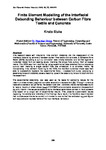Finite Element Modelling of the Interfacial Debonding Behaviour between Carbon Fibre Textile and Concrete
| dc.contributor.author | Stuka, K. | |
| dc.date.accessioned | 2020-10-10T19:47:22Z | |
| dc.date.available | 2020-10-10T19:47:22Z | |
| dc.date.issued | 2020 | |
| dc.identifier.citation |
Stuka, K. (2020) ‘Finite Element Modelling of the Interfacial Debonding Behaviour between Carbon Fibre Textile and Concrete’, The Plymouth Student Scientist, 13(1), p. 328-348. | en_US |
| dc.identifier.uri | http://hdl.handle.net/10026.1/16515 | |
| dc.description.abstract |
This research deals with integrating finite element modelling into the investigation of the interfacial debonding behaviour between carbon fibre textile and concrete. A Cohesive Zone Model (CZM) replicating a pull-out simulation was initially validated and verified against a numerical model from an existing study, involving the single fibre pull-out from an epoxy matrix. The CZM was then modified by using experimental data obtained from a laboratory pull-out test involving a single carbon fibre tow embedded in a concrete matrix. By incorporating finite element modelling to the CZM, the modified numerical model was then able to successfully replicate the experimental force – displacement curve; producing a debonding force of 0.9082kN, closely matching up with the debonding force of 0.9021kN from the experiment. The experimental debonding load was used as the basis for calibrating values for the maximum shear stress (τmax) and complete separation displacement (δs). Through numerous trials and a series of adjustments, the carbon fibre tow – concrete matrix interface was found to have a maximum shear stress (τmax) of 6.475MPa at a complete separation displacement (δs) of 0.775mm. The values corresponding to interfacial parameters defined in the study were only based on a single set of experimental results. This presents questionable issues regarding the validity and reliability of the findings. As a result, it is therefore recommended that multiple experiments be carried out in order to ensure that the calibrated τmax and δs are both accurate and representative of the true interfacial behaviour. | en_US |
| dc.language.iso | en | en_US |
| dc.publisher | University of Plymouth | en_US |
| dc.rights | Attribution 3.0 United States | * |
| dc.rights.uri | http://creativecommons.org/licenses/by/3.0/us/ | * |
| dc.subject | Finite Element Modelling | en_US |
| dc.subject | Interfacial Debonding Behaviour | en_US |
| dc.subject | Carbon Fibre Textile | en_US |
| dc.subject | Concrete | en_US |
| dc.subject | Cohesive Zone Model | en_US |
| dc.subject | CZM | en_US |
| dc.subject | carbon fibre tow | en_US |
| dc.subject | concrete matrix interface | en_US |
| dc.title | Finite Element Modelling of the Interfacial Debonding Behaviour between Carbon Fibre Textile and Concrete | en_US |
| dc.type | Article | en_US |
| plymouth.issue | 1 | |
| plymouth.volume | 13 | |
| plymouth.journal | The Plymouth Student Scientist |



